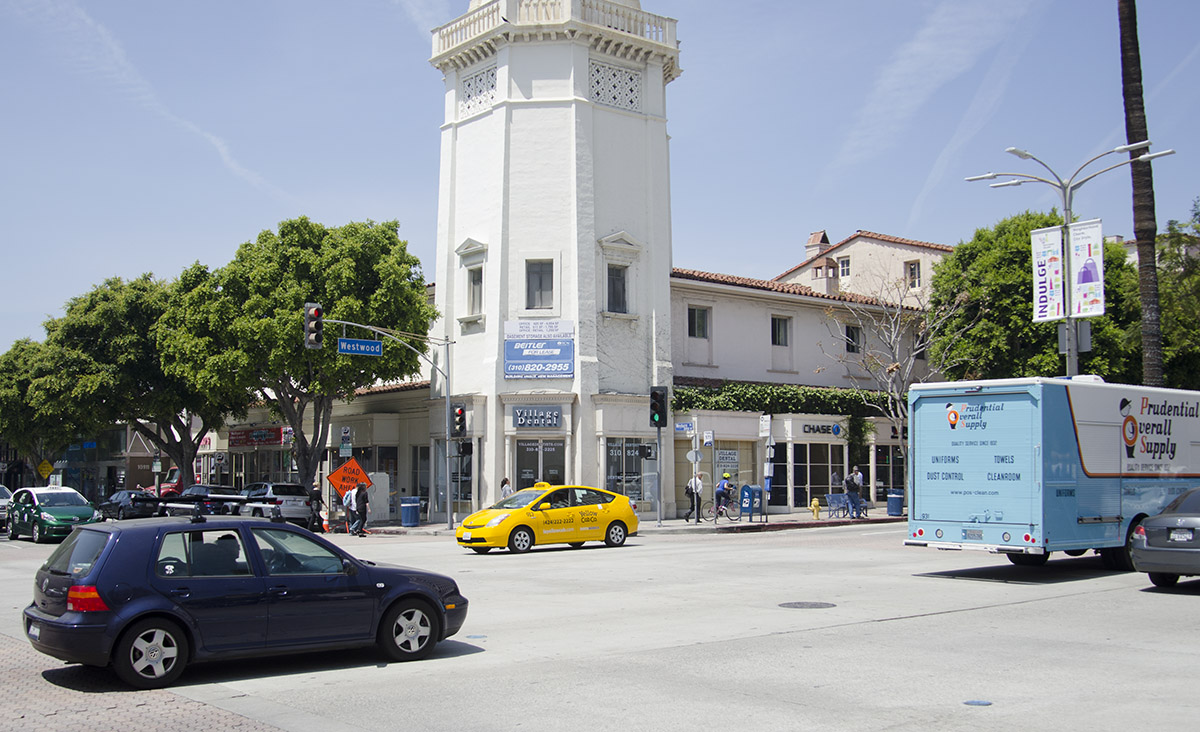Westwood, for rent: One Village, many interests

Westwood Village’s various consumer and community interests rarely meet and intersect. (Daily Bruin file photo)
By Roberto Luna Jr.
Nov. 20, 2015 5:57 p.m.
When you’re working on a group project for a class, the best thing to do to get a good grade is to work together. You can either split up the work or work on every question together after a consensus has been made. Nothing would get done without cooperation, and it would certainly be harder if one member goes rogue.
Improving Westwood Village will be a group project. Many types of people – UCLA students, residents, professionals, landlords – use the Village and each of them has played an impact on how it has developed.
The Village, being a historically important district, means so much to so many people. One move that benefits a certain group may not fit well another.
Not only do all these different types of people live, shop and dine in Westwood, they also want their voices heard. Few neighborhoods in the city have this much involvement from the people that live in them.
There are too many voices in Westwood, however, and everyone wants to be heard. Taking this into consideration, it will be nearly impossible to accommodate everyone if there isn’t any coordination. Each has its own agenda on what they believe is best for the neighborhood. If someone were to look at Westwood from the outside, the most practical thing to do is to work together.
The earliest forms of community involvement started with homeowners’ associations around the 1960s. Residents got together to fight proposed freeways along Sunset and Santa Monica boulevards near their residences and ended up forming groups to voice their concerns about other matters, said Steve Sann, chair of the Westwood Community Council and longtime Westwood resident.
Secondly, there have always been students. They’re the Village’s primary customers and the ones that frequent it the most. They have the platforms to voice their opinions, such as by joining student groups or bringing concerns to student governments.
Lastly, the business community, made up of landlords and storeowners, literally decides what Westwood Village will look like. From the type of stores they lease to how they maintain their buildings, property owners play a huge impact in what direction Westwood can go.
Topa Management, which owns a significant amount of property in the Village, is selective about the stores they lease to, bringing higher-end retail such as Paper Source and Sur La Table and exclusive restaurants such as 800 Degrees Neapolitan Pizzeria and KazuNori. Other landlords, such as the Holmby Hall clock tower building’s owner, leave storefronts vacant for months, only signing leases to stores that don’t care to specific needs, such as the 7-Eleven that is in the works.
Another organization, the Westwood Village Improvement Association, also known as the BID, is in charge of managing the Village. It offers city services, such as street cleaning and tree-trimming, to the Village and acts as a liaison between the business community and the city. More recently, it has begun on focusing on longer-term goals, such as the arrival of the Express Park and planning a community plaza.
The city also formed the Westwood Neighborhood Council in 2010, a year after the Westwood Community Council began, in an attempt to make residents’ voices and concerns heard. They receive about $40,000 annually from the city for community projects.
The saturation of councils and organizations is both a positive and negative to Westwood. It shows that Westwood is an active community and ensures that voices are heard. But if these voices cannot cooperate, it diminishes the point of these organizations.
When the BID does take initiative on a long-term project, for example, it is often met with resistance.
The BID’s postponed Broxton Avenue Plaza project proposal from last week is just one example of how the BID and residents do not connect. The BID did not reach out to the community about the matter, although it would have closed a street entirely and would have probably meant an increase in foot and vehicular traffic in the area.
While the intention was good, and as much as I would have loved to see a plaza in Westwood Village, seeking a big change without asking the input of the community will certainly lead to disagreements.
In other cases, residents do not take the time to hear the BID’s ideas. When the BID agreed to cooperate with a UCLA graduate class to analyze the Westwood Village Specific Plan, a 20-year-old master planning document meant to balance the types of businesses in Westwood Village, it was met with resistance.
While well-meaning residents have greater permanence and seniority in the Village, the students, as fickle as their presence is, have a predictable set of interests as a consumer demographic and, by sheer population size, put more money into the Village than the residents.
Instead, like in a group project, all parties need to negotiate for a successful result – because Westwood deserves to get an A.
Next week: The policies and plans that hamper Westwood’s growth.


